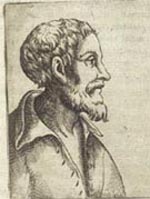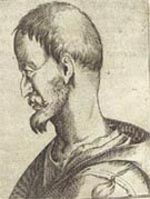
The History of Physiognomy
A Leverhulme Trust International Network
Queen Mary University of London (London), Ecole Normale Supérieure (Paris), and Scuola Normale Superiore (Pisa)

 |
The History of PhysiognomyA Leverhulme Trust International NetworkQueen Mary University of London (London), Ecole Normale Supérieure (Paris), and Scuola Normale Superiore (Pisa) |
 |
|
HomeAbout the NetworkAbout PhysiognomyContactMembersParticipantsEventsBibliographyResources/Links |
Jean Dagen (Université Paris-Sorbonne)'Qu'en pensent les Encylopédistes et les philosophes'? L'hypothèse physiognomonique (selon Delle Porta et Lebrun) d'un rapport nécessaire du caractère intellectuel et moral de l'individu avec sa conformation physique, c'est-à-dire de l'homme intérieur avec l'homme extérieur, ou de la nature propre avec l'apparence, est ignorée semble-t-il, ou délaissée par le premier 18 e siècle français. Les analyses d'un Marivaux, en ce sens exemplaires (dans le Cabinet du philosophe ), excluent la possibilité de faire science d'une telle théorie tant l'accès à la connaissance des pensées et des affects d'autrui y devient problématique, dépendant notamment des conditions de l'examen et du point de vue de l'observateur. Les conceptions de Marivaux, partagées, au moins implicitement, par Fontenelle autant que par Voltaire, se trouvent confirmées par les pages ironiques de Kant dans son Anthropologie du point de vue pragmatique. Entre-temps l'article « Physionomie » de l' Encyclopédie , dans lequel Jaucourt se réclame de Buffon, dénie toute valeur à cette « science ridicule », à prétention « divinatoire », fondée sur un préjugé antique (« comme l'âme n'a point de forme qui puisse être relative à aucune forme matérielle, on ne peut la juger par la figure du corps ou par la forme du visage »). L'article « Expression » de Watelet, prolongé par l'article « Passion » du même, propose une réflexion d'inspiration très traditionnelle, relevant d'une typologie toute pathognomonique, sur l'art d'exprimer les passions dans la peinture. Cette orientation est renforcée par le Diderot des Salons , par la théorie du modèle dans le Salon de 1767 en particulier. Mais, comme on sait, la pensée esthétique de Diderot n'est pas indépendante de son monisme vitaliste, doctrine unificatrice tendant à assimiler le psychique et le physique ou le physiologique, se rapprochant, sous le couvert d'un éclectisme néo-platonicien, des thèses physiognomoniques. Cette orientation ne serait pas démentie par le long compte rendu des Essais sur la physiognomonie de Lavater, traduits et publiés en 1782, et commentés dans la Correspondance littéraire (octobre 1782) : Grimm, sans renoncer à toute réserve, présente avec sympathie et cite longuement les arguments de Lavater en faveur de la nouvelle science. Cette critique modérée mais engageante est contemporaine des écrits de celui qui se révèle le plus proche de Lavater, qu'il rencontra, qui l'intéresse au point de lui inspirer des chroniques successives, au point de donner à la doctrine du maître des prolongements de caractère illuministe, précieux surtout par le lien qu'ils font apparaître entre physiognomonie et peinture. On ne manquera pas de noter que les vues singulières de Louis Sébastien Mercier se verront, en quelque sorte, entérinées par la dialectique hégélienne. Ainsi se confirme-t-il que la vogue de la physiognomonie dans les dernières années du 18 e siècle coïncide avec la montée d'un irrationalisme dont on fait volontiers l'un des traits majeurs de ce qu'on nomme romantisme et qui témoigne de la collusion de la philosophie post-kantienne avec le mysticisme et l'individualisme d'inspiration piétiste.
The Views of the Encyclopédistes and the Philosophes. The physiognomic hypothesis of Della Porta and Le Brun that there is a necessary relationship between the moral and intellectual character of the individual and his physical organisation - that is to say, between internal man and external man, or then again between real character and appearance - seems to be ignored or to have been abandoned by the early 18 th century. In the Cabinet du philosophe, Marivaux - who is exemplary on this point - rejects the possibility of producing a scientific analysis through such a theory, since it problematises access to knowledge of the thoughts and affects of others, and also on the conditions of such scrutiny and the observer's perspective. Marivaux's notions were shared, at least implicitly, by Fontenelle and Voltaire, and would be endorsed in some ironical pages of Kant's Anthropologie du point de vue pragmatique. Before this appeared, Jacourt's article on 'Physionomie' in Encyclopédie, which drew on Buffon, denies any value to 'this ridiculous science', with it 'divinatory' claims and its grounding in ancient prejudice ('as the soul has no form which could relate to any material form, we cannot judge it by the shape of the body or the form of the face'). Articles in the Encyclopédie by Watelet - on 'Expression' and 'Passion' - provide a very traditional account of ways of representing the passions in painting, grounded in a pathognomic typology. This orientation is endorsed by Diderot in the Salons, notably by his theory of the model in the Salon de 1767. Yet as we know, the aesthetic theories of Diderot are not independent of his vitalist monism, and this unifying doctrine tends to assimilate the psychic to the physical or the physiological. This Neo-Platonic eclecticism in fact surreptitiously brings him close to physiognomic hypotheses. Such an approach was not belied by the long review of Lavater's Essais sur la physiognomonie (published in translation in 1782) that appeared in the Correspondance littéraire in October 1782: though he retained reservations, Grimm presented Lavater's arguments in favour of the new science sympathetically and with long quotations. This moderate yet involved criticism emerges at the same time as writings of a figure who proved closest to Lavater, whom he met, who interested him enough to devote successive accounts to him, so that he gave the master's doctrines a kind of illuminist prolongation, all the more interesting for the links they establish between physiognomy and painting. It should be noted that the singular views of Louis-Sébastien Mercier would be enshrined in the Hegelian dialectic. Thus the phenomenon confirms that the vogue for physiognomy in the final years of the 18 th century coincides with the rise of an irrationalism which is generally taken to be characteristic of what is usually called Romanticism and which highlights the collusion of post-Kantian philosophy with the mysticism and individualism inspired by Pietism.
Go back to Physiognomy from Della Porta to Lavater
|
|||||